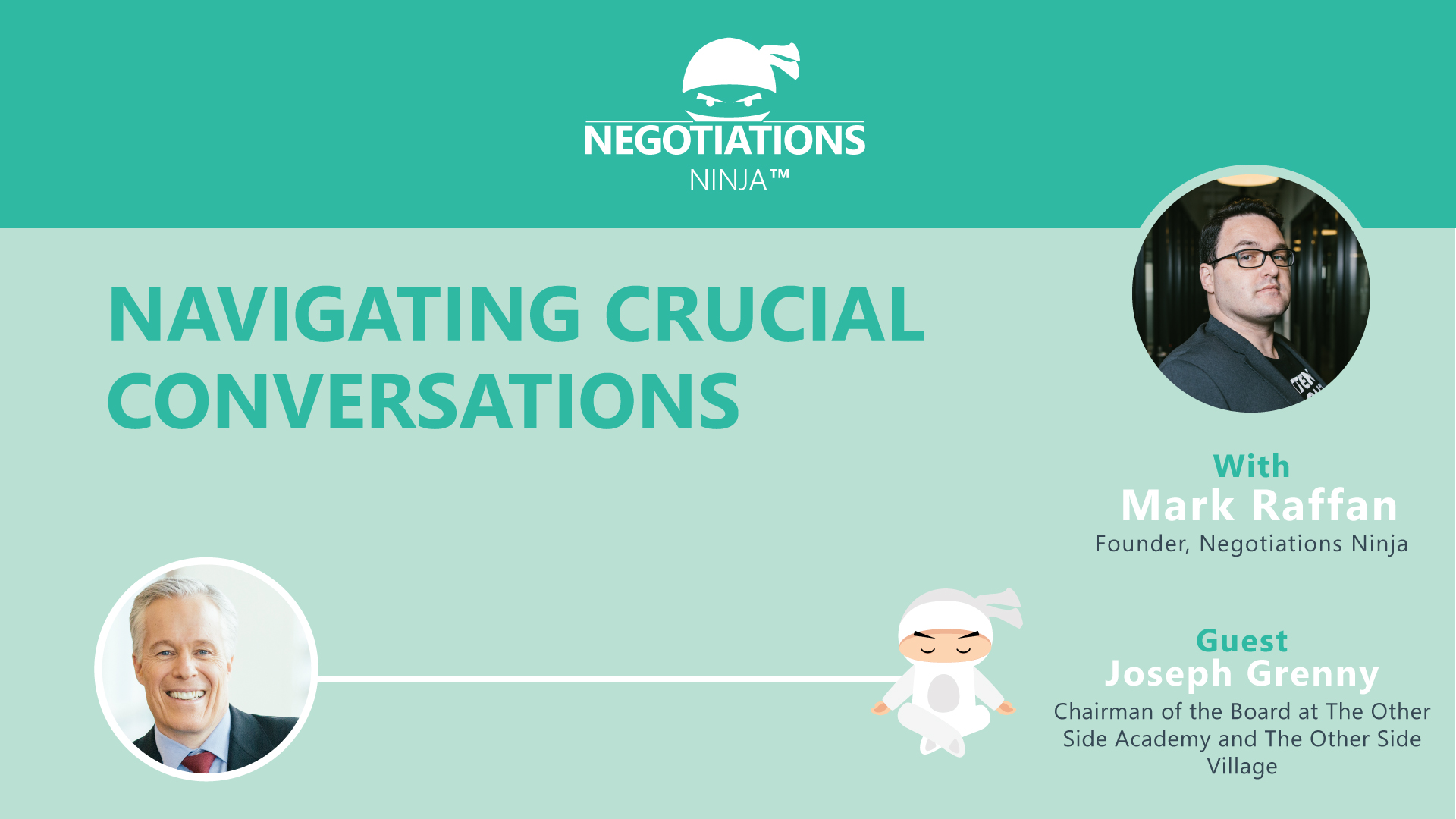According to the author of “Crucial Conversations,” Joseph Grenny, crucial conversations are a discussion between two or more people where the stakes are high. Sometimes our opinions vary, and our emotions run strong. How do we deal with conversations like that? Learn how to navigate crucial conversations successfully—while maintaining your relationships—in this episode of Negotiations Ninja!
Outline of This Episode
- [1:49] Learn more about Joseph Grenny
- [3:38] How to have crucial conversations
- [6:24] What is your “style under stress?”
- [13:03] Crucial conversations in the workplace
- [16:01] Why we handle personal stress differently
- [18:02] Joseph’s nonprofit: The Other Side Academy
- [20:12] You can tell the truth in a loving way
- [23:18] How do you maintain the changes you make
Crucial conversations are difficult because they’re threatening
We must recognize that our inability to have crucial conversations is the problem. It isn’t a division about opinions. Opinions become more entrenched the more threatened we feel. There’s always tension between two competing values—safety and prosperity. Your instant response is: Can I survive this moment? What are the results I’d like to achieve?
The challenge in achieving prosperity is that we reframe everything as a safety issue. We feel psychologically threatened during these conversations, which heightens anxiety and causes us to show up defensively. That trumps the ability to have an effective conversation about what would make us more prosperous.
What would heal the world? What would make us feel safer? What would improve the economy, our organization, or our families? Humans are wired to prioritize safety and prosperity in very specific ways. The part of our brain that retains operational control is the part that keeps us alive.
If I perceive someone as different, they represent a threat to me and my interests. That drives how I respond to the entire potential engagement. But if we learn to recognize and manage this tendency, we can thrive. So you have to start by learning your “style under stress.”
What is your “style under stress?”
One of the master skills you can learn from Joseph’s book is “Learn to look.” You have to train yourself to become aware of your own “style” when you’re under stress. If your style is combativeness, you default to aggressiveness, overstating concerns and attacking others’ arguments. Or maybe your chest gets tight, and you clench your jaw and raise your voice.
When you notice those cues, code them, and recognize them as evidence of a crucial conversation, you can invoke a host of skills that will help you show up in the moment. But it starts with recognizing that you’re stressed. 99% of the time, there is no threat—it’s simply your perception. Having different opinions on an issue doesn’t need to be threatening. Everything will be okay.
A cognitive intervention to refocus your mind
The amygdala takes control when you’re stressed, and higher reasoning centers get shut down. You have to turn those higher reasoning centers back on. The best way to do that is to present a question to your brain that you’ll have to ponder. It makes you shift focus from the “threat” you’re experiencing to acknowledging your long-term motivations. Once you acknowledge those motivations, your physiology changes.
So once you recognize that you’re feeling stressed and/or threatened, you need to ask yourself: “What do I really want at this moment? What do they want? What do I want for this relationship?” This cognitive intervention is so effective in calming someone down and refocusing on long-term objectives because it presents your brain with a question it’s too stupid to answer in its dumbed-down condition.
We are adapted to a world that doesn’t exist anymore. But we have the hardware that can allow us to discern and intervene in moments we feel threatened. You have to flip the switch and think about long-term objectives, which makes it far more achievable.
How can you promote a healthy culture for employees to have these crucial conversations? Learn more in this fascinating episode of Negotiations Ninja!
Resources & People Mentioned
- Influencer: The New Science of Leading Change
- Crucial Conversations: Tools for Talking When Stakes Are High
- Style Under Stress Assessment
Connect with Joseph Grenny
- Joseph’s website
- The Other Side Academy
- Connect on LinkedIn
- Check out Joseph’s books
Connect With Mark
- Follow Negotiations Ninja on Twitter: @NegotiationPod
- Connect with Mark on LinkedIn
- Follow Negotiations Ninja on LinkedIn
- Connect on Instagram: @NegotiationPod




